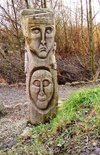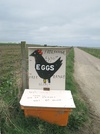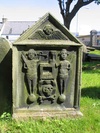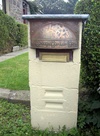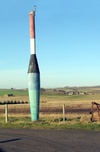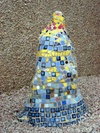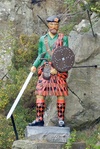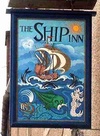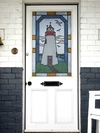|
A square concrete block of the kind that once covered much of the coasts of Britain and Europe, with carved graffiti. Blocks of concrete such as this still stretch all the way from Aberdeen to the mouth of the River Ythan at Newburgh. There are also extant examples on more northerly Aberdeenshire beaches that could have been used for landing. Built in 1940 they were designed to prevent tanks landing during the feared Nazi invasion. Some have simple graffiti on them but this one was richly decorated by Louis Lawson. There is a caricature of Churchill who is watching Hitler looking upwards at a bomb falling from the sky. At the bottom there is the chilling message "Hitler's Graveyard".
More Information
|
|
Tarlair – Art Deco outdoor swimming pool and boating pond opened in the 1930’s, it was once very popular with tourists, now falling into disrepair, no swimming allowed any more, disused since 1995, currently only used by model boat owners. Classified ‘A’ listed in 2007 by Historic Scotland.
John C Miller (Macduff Burgh Surveyor) 1930-31 with minor later alterations. Art Deco tidal swimming pool, boating pool and paddling pool surrounded by curved walkways, with associated tea pavilion at head of boating pool and changing rooms and kiosks to side. Concrete pools and buildings.
BOATING POOL, SWIMMING POOL AND PADDLING POOL: D-plan boating pool bounded by 3 broad walkways swept round from tea pavilion at head of pool; shallow steps cut into walkways at regular intervals; ramp for boats to E of tea pavilion. Rectangular paddling pool with curved corners enclosing natural rocky outcrop within the boating pool and directly in front of tea pavilion. Rectangular swimming pool to N (sea side) of boating pool with changing rooms at W end; continuation of lower walkway divides boating pool from swimming pool; middle walkway continued round to E end of pool.
TEA PAVILION: single storey, break-fronted rectangular-plan, flat-roofed Art Deco tea pavilion with 3-bay colonnade between taller end pavilions; steps at outer bays leading to roof terrace; simple horizontal railings to roof. Later 2-bay addition to W. Doors and windows boarded up (2006).
CHANGING ROOMS: low, flat-roofed group of 4 linked blocks with slightly advanced outer bays. Strip windows at eaves level (boarded up, 2006).
KIOSKS AND FENCE: probably early 1950s. 2 1-bay, roughly square-plan kiosks at pool entrance. Curved concrete fence with perforated top extends towards tea pavilion.
Tarlair Well – Tarlair Well a chalybeate spring east of Macduff was discovered in 1770 and ten year later in 1780 the Earl of Fife built the ‘Well House’ and the croft. The well was once renowned for its medicinal properties and was very popular for the ‘taking of the waters’ in the 19th century. The well ceased to flow after a German mine exploded when it came ashore in ‘World War Two’. Local drinks manufacturer Sangs traced the source of the well and are said to make all their drink products with this water. The well-house remains although in poor condition, nothing remains of the croft. The well house is category C listed.
Later 18th-early 19th century. Small rectangular rubble wellhouse with later harling. Blocked entrances in E and W gables. Small soak-away vent in base of N elevation. Piended bellcast concrete roof, probably replacing earlier stone slab covering.
INTERIOR: vaulted rubble interior; dished stone gutter runs through centre; rough stone benches against W wall.
A cottage/crofthouse once stood nearbye but during WW2 the same mine which came a shore destroyed it.
The Crazy Frog (Face in the rocks)
A natural face in the rocks which has had its mouth eyes and nostrils added to bring it out.
Painted in 2007.
Cleaved Head, Macduff – Site of a promontory fort, typical in type of the iron age, a scheduled ancient monument, two ditches and traces of a third are evident. The construction of a golf course (Tarlair Royal Golf Club) has altered the landscape around the ditches, but the easternmost ditch is still the best preserved, having a scarp 1.5m high and a counterscarp 0.5m high; no evidence of fortification was seen on the flattish top of the promontory . Grid ref NJ 721 647. Spectacular views of the rugged coastline eastward to Troup Head can be had from here.
More Information
|
|
A painting of a Tasmanian Devil in the style of the well known cartoon character "Taz", It is obviously desired to keep the original rendering as it predates the last painting of the wheelhouse as indicated by some overpainting of the left leg.
More Information
|
|
A painted faux window in a house gable with a lucky black cat peering through it.
More Information
|
|
Another cartoon character used as a trawler decoration. The 2007 photo on www.trawlerphotos.co.uk is interesting in showing just how much damage to a paint job less than a year at sea can do.
More Information
|
|
The Tolquhon Monument, built by Thomas Leper in 1589, of a chocolate- coloured sandstone, to commemorate William Forbes of
Tolquhon (perhaps to Forbes' design) and his wife Elizabeth Gordon, is supposed to be the relic of the S. aisle of the old kirk. Rich arched altar tomb mixed gothic and Renaissance motifs inspired by Dunbar tomb at St. Machar's, Cathedral.
It is somehow very Scottish in style.
Present pedimented setting probably of 1798. The monument is housed in a classical surround believed to be of 1798 in date, though a large porch has been erected by Historic Scotland consisting of sheets of perspex with bronze structural supports. The tombstone is remarkably well preserved with its representative figures, though the structure preserving it rather resembles a domestic green house.
Coats of arms as shown for William is 'Forbes quartered with Preston' and shown for his wife is 'Forbes impaled with Gordon'.
The charges on the shields show, heads of boars, unicorns and muzzled bears. The unicorns appear again at the top of the arch either side of the crown flanked by hounds hunting on the right a deer and on the left another animal I cannot definitely identify (perhaps a fox or martin).
More Information
|












